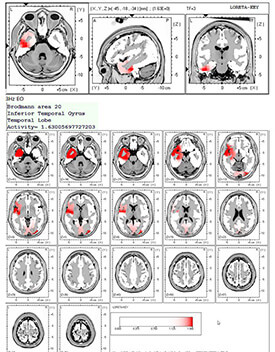Quantitative EEG (QEEG)
Quantitative EEG (sometimes referred to as brain mapping or QEEG) has scientifically documented ability to aid in the evaluation of conditions such as mild traumatic brain injury, ADD/ADHD, learning disabilities, stroke, epilepsy, and to predict outcomes from treating conditions such as ADD/ADHD, alcoholism and drug abuse.
Using neurofeedback (also known as EEG biofeedback or neurotherapy) to treat conditions has been scientifically documented to be successful with ADD/ADHD, closed head injuries and addictions.
QEEG and neurofeedback, is the measurement through digital technology of electrical patterns at the surface of the scalp, which primarily reflect cortical electrical activity or “brainwaves.” QEEG is one of the more reliable tests in demonstrating and quantifying white matter pathology.
Since 1989 with the work of Thatcher, et. al. on mild head trauma, use of QEEG for accurate diagnosis has become routine. The work has been validated, replicated and reviewed in the literature by experts in refereed journals, meeting the strictest clinical standards in medicine; a sampling of references is at the end of this article.
The American Medical EEG Association Ad Hoc Committee on QEEG has stated that QEEG “is of clinical value now and developments suggest it will be of even greater use in the future.”
Since 1977, there are over 2,000 publications in journals and books of studies concerning the clinical application of computerized EEG to a wide variety of disorders.


Procedure
The procedure for a QEEG takes about 1½-2 hours. It is non-invasive, and no electrical current is put into the brain. It consists of placing a snug cap on the head which contains small electrodes to measure the electrical patterns coming from the brain. Information is gathered on the brainwave patterns and the efficiency of communication between different parts of the brain. This is done while the client sits with eyes open, then eyes closed and while doing one or two cognitive tasks. After the client leaves the office, there is a lengthy office procedure to remove any artifacts that occurred when the eyes moved or blinked, facial muscles tightened or the client moved slightly in the chair.
This artifacted data is then compared to a number of sophisticated data bases of the brainwaves of individuals of the same age and sex who have been intensely screened for normality. This highly statistically accurate analysis is more sensitive than MRI, CT scan or neurological examination in diagnosing white matter injury, since it measures microscopic changes. This assessment procedure helps determine in a highly scientific and objective manner what treatment plan is suitable.
QEEG Assessments: What You Need to Know Before Your Appointment
Your preparation for and performance during the QEEG recording session is critical in order to obtain reliable and accurate results. Please ensure you read the following instructions carefully and adhere to all requests:
- Please arrive with clean hair, free from any creams, gels, hair sprays or other products. You will be asked to wear your hair loose during the assessment so that we may fit the cap on properly.
- If you have a toupee, wig, or corn-rows, please remove or be able to remove for your appointment.
- You may wish to bring a comb and a hair tie, as the saline gel will dry and flake afterwards. We have shower facilities available for your convenience.
- You may wish to bring a scarf or a hat to hide your messy hair afterwards.
Please Avoid:
- Nicotine should be avoided 3 hours prior to your session.
- Alcohol should be avoided 12 hours prior to your session.
- Marijuana should be avoided 72 hours prior to your session.
- Please avoid all recreational drug use for 7 days before your QEEG.
- Do not drink coffee or any caffeine products within 3 hours of your appointment.
- If you are taking stimulant medication, it is preferable to do the QEEG recording after the proper washout time period. Please check with your prescribing physician to determine if it is possible to stop taking the stimulants prior to recording the QEEG. Please contact the Hoffman Centre and speak to a staff member for appropriate half-life prescription washout.
- Be sure to drink plenty of water in the 24 hours before your QEEG and drink at least one glass of water within the hour prior to your QEEG.
- Please bring a current list of all prescribed, over-the-counter, or recreational drugs or herbal/nutritional supplements that you are taking including the doses and last time taken.
- Please be sure to get a good night of sleep before the QEEG. Do not take any prescription or OTC sleep preparations. Let the technician know if there has been any problem with sleep or if you are exceptionally tired on the day of your QEEG.
- Please be sure to have a good breakfast at least 1 hour prior to the QEEG. But avoid eating large or heavy carbohydrate, high fat meals or ingesting high sugar content foods or beverages within 2 hours of your QEEG.
- If you are sick or feel a cold or flu coming on, please call to reschedule.
- Use the restroom if you need to prior to the start of the QEEG because we will not be able to stop once the recording begins.

